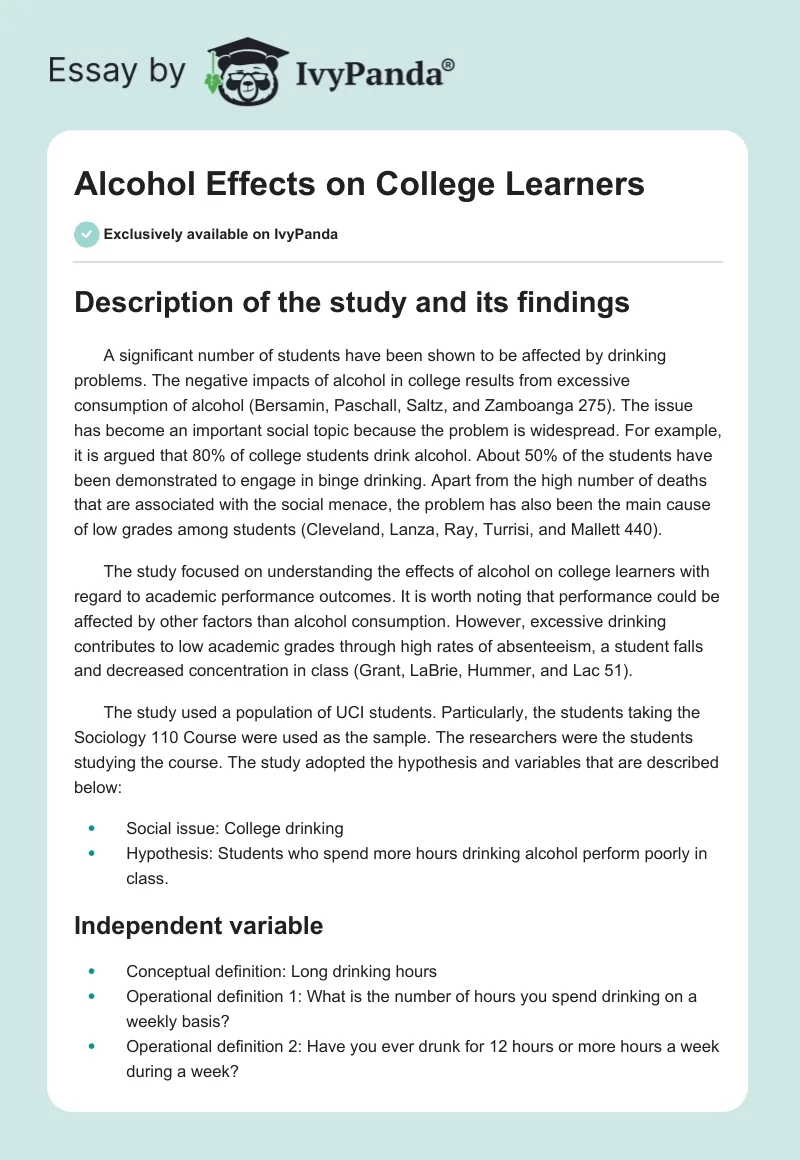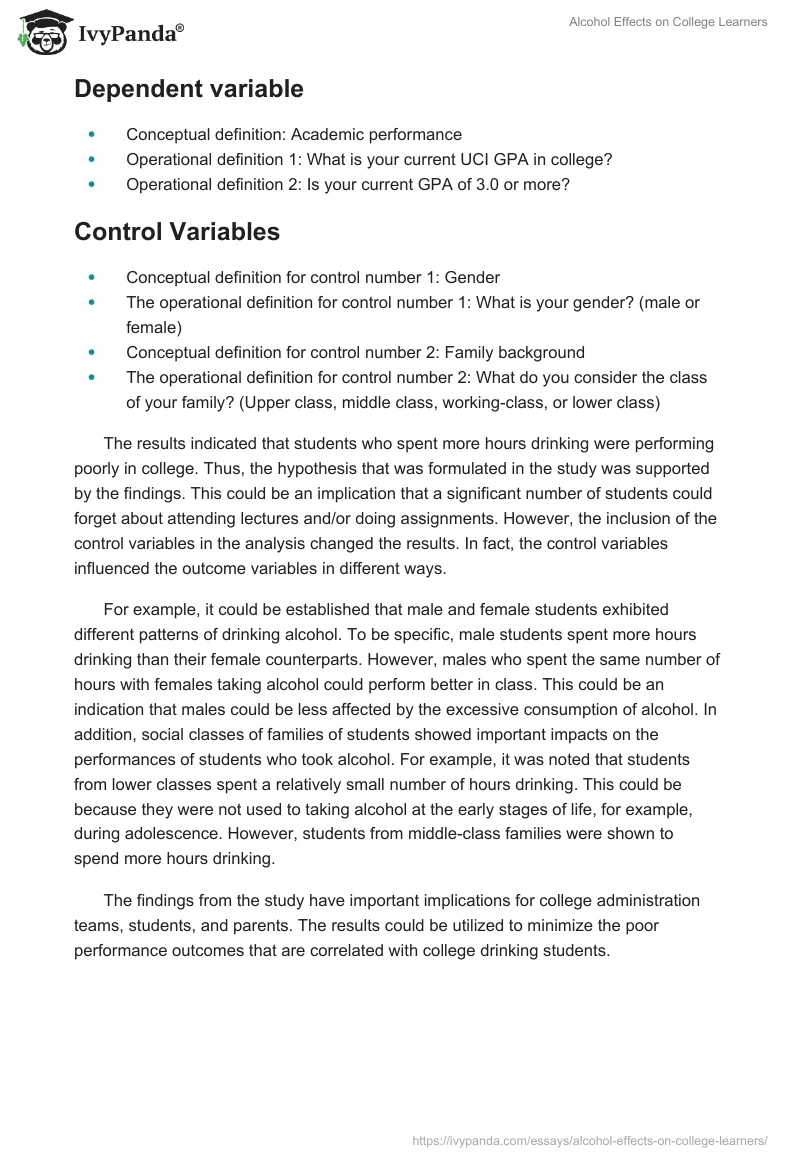Description of the study and its findings
A significant number of students have been shown to be affected by drinking problems. The negative impacts of alcohol in college results from excessive consumption of alcohol (Bersamin, Paschall, Saltz, and Zamboanga 275). The issue has become an important social topic because the problem is widespread. For example, it is argued that 80% of college students drink alcohol. About 50% of the students have been demonstrated to engage in binge drinking. Apart from the high number of deaths that are associated with the social menace, the problem has also been the main cause of low grades among students (Cleveland, Lanza, Ray, Turrisi, and Mallett 440).
The study focused on understanding the effects of alcohol on college learners with regard to academic performance outcomes. It is worth noting that performance could be affected by other factors than alcohol consumption. However, excessive drinking contributes to low academic grades through high rates of absenteeism, a student falls and decreased concentration in class (Grant, LaBrie, Hummer, and Lac 51).
The study used a population of UCI students. Particularly, the students taking the Sociology 110 Course were used as the sample. The researchers were the students studying the course. The study adopted the hypothesis and variables that are described below:
- Social issue: College drinking
- Hypothesis: Students who spend more hours drinking alcohol perform poorly in class.
Independent variable
- Conceptual definition: Long drinking hours
- Operational definition 1: What is the number of hours you spend drinking on a weekly basis?
- Operational definition 2: Have you ever drunk for 12 hours or more hours a week during a week?
Dependent variable
- Conceptual definition: Academic performance
- Operational definition 1: What is your current UCI GPA in college?
- Operational definition 2: Is your current GPA of 3.0 or more?
Control Variables
- Conceptual definition for control number 1: Gender
- The operational definition for control number 1: What is your gender? (male or female)
- Conceptual definition for control number 2: Family background
- The operational definition for control number 2: What do you consider the class of your family? (Upper class, middle class, working-class, or lower class)
The results indicated that students who spent more hours drinking were performing poorly in college. Thus, the hypothesis that was formulated in the study was supported by the findings. This could be an implication that a significant number of students could forget about attending lectures and/or doing assignments. However, the inclusion of the control variables in the analysis changed the results. In fact, the control variables influenced the outcome variables in different ways.
For example, it could be established that male and female students exhibited different patterns of drinking alcohol. To be specific, male students spent more hours drinking than their female counterparts. However, males who spent the same number of hours with females taking alcohol could perform better in class. This could be an indication that males could be less affected by the excessive consumption of alcohol. In addition, social classes of families of students showed important impacts on the performances of students who took alcohol. For example, it was noted that students from lower classes spent a relatively small number of hours drinking. This could be because they were not used to taking alcohol at the early stages of life, for example, during adolescence. However, students from middle-class families were shown to spend more hours drinking.
The findings from the study have important implications for college administration teams, students, and parents. The results could be utilized to minimize the poor performance outcomes that are correlated with college drinking students.
Reflection on the strengths and weaknesses of the study
When conducting a study, it is important to consider the various factors that could contribute to strengths and weaknesses (Creswell 34; Neuman 38). In fact, researchers always aim at ensuring that their study designs have more strengths than shortcomings. With regard to the completed study, it would be important to discuss the study design and implementation, sampling, and measurement.
Measurement
The operational definitions adopted in the study were characterized by a high level of validity. They were formulated on a platform of scientific basis that could be verified through testing of hypothesis. Thus, other researchers could easily notice that they could be relied upon when making inferences about the population (Creswell 98). It could also be stated that the definitions did not introduce any type of errors. It is worth noting that errors could negatively impact the reliability of a study. Overall, there was a high level of measurement of each operational definition used in the study. Both open-headed and closed-headed questions were adopted with a view to getting answers from respondents. The type of answers that were intended to be obtained determined the type of questions used (Neuman 76).
For example, the question about gender was closed-headed because a respondent could be either a female or male. It is believed that the study used the right wording of the questions because the answers obtained were clear. If the wording were not effective, then the respondents could have provided unclear responses.
Sampling
The universe of the sample used in the study could be stated as being the entire number of students in the college where the research was conducted. The sampling frame in the study was complete because it contained all students and their full details with regard to drinking behaviors, gender, and family backgrounds. A simple random sample was utilized. It was this type of sample because the respondents were picked in a random manner from a group of potential study participants. With regard to the sample, repetitions could not be accepted in the study because the population was numbered from 0 to n.
It is important to note that the results could be generalizable to larger populations. Particularly, they could be applied to colleges with larger populations in different social settings. In justifying the aspect of generalizability, it is worth noting that college populations have students who have similar trends in drinking patterns and family backgrounds. Due to this aspect, the results could be applied to different institutions of learning to bring about social changes that could be associated with alcohol drinking among students.
Survey design and administration
The study used a cross-sectional survey design, which implied that data were collected at a particular time without the need to follow drinking patterns among participants over time. The survey was administered using the face-to-face approach. The approach has both merits and demerits. One merit of the survey design is that a researcher could clarify issues to respondents, for example, by rephrasing questions (Neuman 75). In addition, it is practical to study facial expressions of study participants (Neuman 76). However, the design is characterized by the demerit of high expenditure. For example, it requires a significant amount of money for researchers to travel. In addition, the training of persons to collect data is also expensive.
Conclusion
The survey was very effective in understanding the relationships among the three types of variables that were studied. It helped to establish that family backgrounds have important roles with regard to college drinking. For example, it was shown that students from the middle class have more tendencies to engage in alcohol drinking while in college. This could be attributed to the early alcohol exposures that are associated with the families because they could afford to purchase alcoholic drinks. Important lessons were learned from the survey. First, it was shown that the choice of survey design could have vital implications on the overall results.
For example, the decision to adopt an approach that could lead to the collection of a limited amount of data could imply that findings could not be used to make a conclusion about a population. Second, it was learned that, although independent variables are mainly influenced by dependent variables, control variables also have impacts on the outcome variables. The associations among the three types of variables result in a complicated network of outcomes. Third, it was learned that the methods that are used to analyze data could largely determine the validity and reliability of findings.
If the study were to be repeated, it would be important to do some things differently. For example, it would be wise to increase the sample size to increase the level of reliability. In addition, it would be essential to conduct the study in many colleges so that better results would be attained.
Works Cited
Bersamin, Melina , Mallie Paschall, Robert Saltz, and Byron Zamboanga. “Young adults and casual sex: The relevance of college drinking settings.” Journal of sex research 49.2-3 (2012): 274-281. Print.
Cleveland, Michael, Stephanie Lanza, Anne Ray, Rob Turrisi, and Kimberly Mallett. “Transitions in first-year college student drinking behaviors: Does pre-college drinking moderate the effects of parent-and peer-based intervention components?.” Psychology of addictive behaviors 26.3 (2012): 440. Print.
Creswell, John. Research design: Qualitative, quantitative, and mixed methods approaches. Thousand Oaks, CA: Sage, 2013. Print.
Grant, Sean, Joseph LaBrie, Justin Hummer, and Andrew Lac. “How drunk am I? Misperceiving one’s level of intoxication in the college drinking environment.” Psychology of addictive behaviors 26.1 (2012): 51. Print.
Neuman, William. Social research methods: Qualitative and quantitative approaches, Upper Saddle River, NJ: Pearson, 2010. Print.


